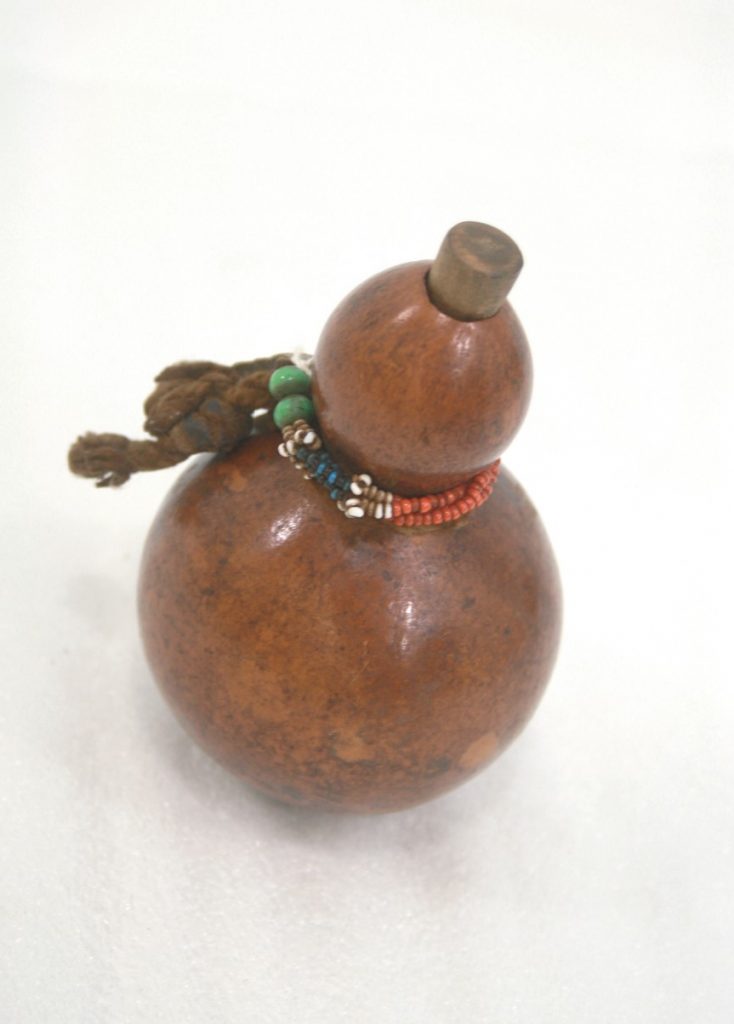
Listen to the pronunciation
| What is this? | Medicine container |
| isiZulu Name | Igona or Isigodlo or Isigubhu |
| isiXhosa Name | Not yet documented. |
| English Name | Medicine container |
| Which cultural group created this? | Zulu |
| Who made this? | Not yet documented. |
| When was it made? | Not yet documented. |
| Where was it made? | Hlazagazi, KwaZulu-Natal |
| Measurements | Not yet documented. |
| How was it made and what is it made of? | Hollowed out calabash with drilled hole on top. Cork closing hole (wood?) and cord with coloured beads fastened around. |
| What colour is it? | Calabash: orange and brown Cork: dark brown Cord: dark brown Beads: red, white, blue, and green |
| What sound does it make? | Not yet documented. |
| Physical description | Calabash with the shape of two sphere packing (bigger on bottom, smaller on top). Hole on the top of the smaller sphere with cork (wood?) closing it. And cord (vegetal?) with coloured beads (red, white, blue, and green) around the spheres’ joining area. |
| Where is it now? | Iziko Museum, Cape Town, South Africa Museum ID: SAM 11970 Kingsley-Holgate Other no. H/2/81 Accessioned in April 1981 (purchase) Store B27/d contd. |
| How did it get there? | Kingsley-Holgate Collection, Accession date April 1981 |
| Why is it important? | This igonna (medicine container) is made with a calabash. The igonna is used as a medicine container, and it is a powerful object because it contains powerful medicine. It should only be opened by someone aware of the power inside it. Usually it is used by traditional healers who speak to the muthi (medicine) inside. The healer can create a connection with the muthi (medicine) inside the igona before opening it, so they know what is inside and how powerful it is, and can give it a personal name. Traditional healers speak to the muthi whether to be aware of its power or when performing a ritual. The igonna is stored in a sacred place in the healer’s hut (isigodlo), and is not supposed to leave that room nor the hut. A different type of container can be used to collect the spirits of people who died away from home so that the family can take them home. The muthi is a mixture of oils and other elements (often animal bones). After mixing the muthi with the bones, you can resurrect dead animals and talk with them, connect with them, and hear a healer speak with them. A healer can speak with animals to understand what is wrong with one person and what makes them sick. Muthi can also be used to heal people. Izizwe medicine can also be used when someone has stolen something from you, so they bring it back, or if your partner has left you, so they come back with you. There is another type of medicine for getting help when looking for employment or if you want money. |
| Notes | Not yet. |
| References | Amagugu Ethu Workshop, Recording STE011: Skhumbuzo Miya Amagugu Ethu Workshop, Recording STE013, min. 01:43 to 03:06: Skhumbuzo Miya Amagugu Ethu Workshop, Recording STE021, min. 30:14 to 31:45: Laura Gibson and Skhumbuzo Miya Amagugu Ethu Workshop, Recording STE021, min. 1:07:09 to 1:12:30: Skhumbuzo Miya, Mbongeni Nomkhonwana Amagugu Ethu Workshop, Recording STE027, min. 00:01 to 18:56: Skhumbuzo Miya, Thulani Thusi, Thulisiwe Mtshali, Lailah Hisam, Boyzie Myeni and Smangaliso Makhalima Amagugu Ethu Workshop, Recording MVI4737: Skhumbuzo Miya, Thulani Thusi, Thulisiwe Mtshali Iziko Museum Catalogue Card SAM 11970 |
| Who described this? | Described during Amagugu Ethu Workshop by Skhumbuzo Miya, Laura Gibson, Mbongeni Nomkhonwana, Thulani Thusi, Thulisiwe Mtshali, Lailah Hisam, Boyzie Myeni and Smangaliso Makhalima. Described by Clara Giménez-Delgado (August 24, 2020). |